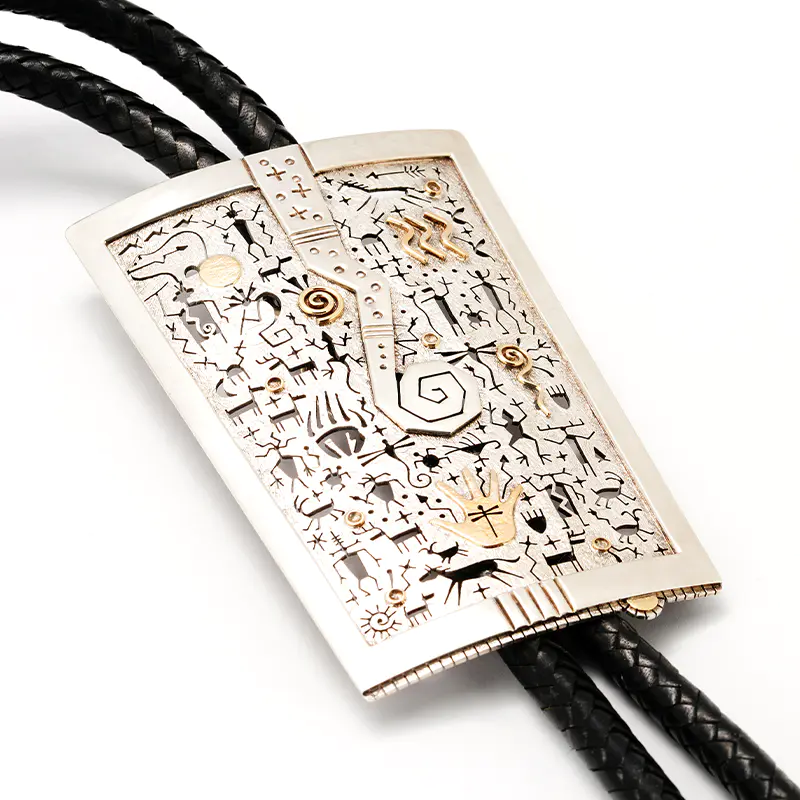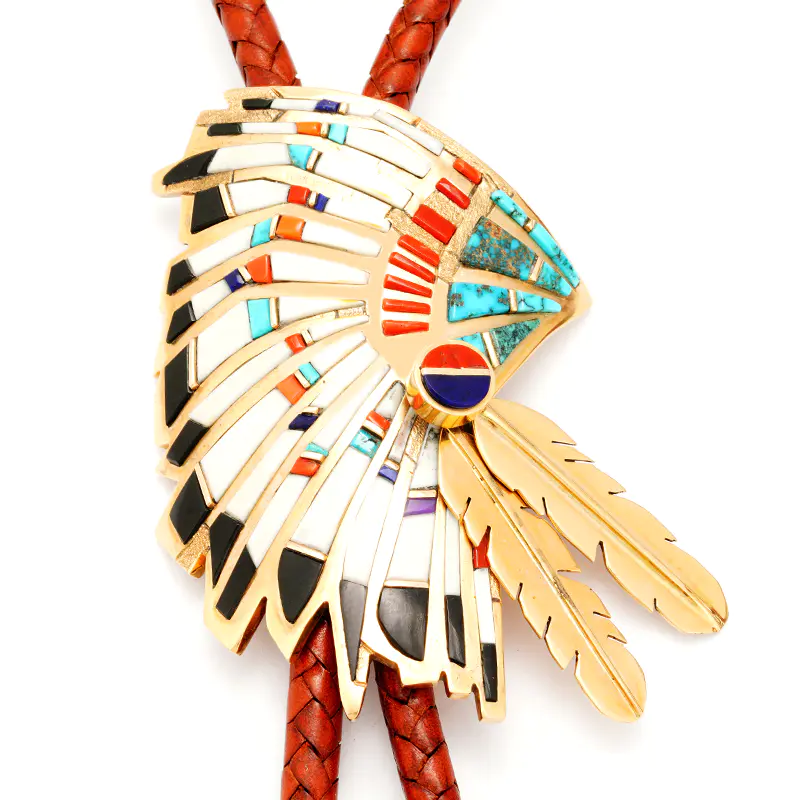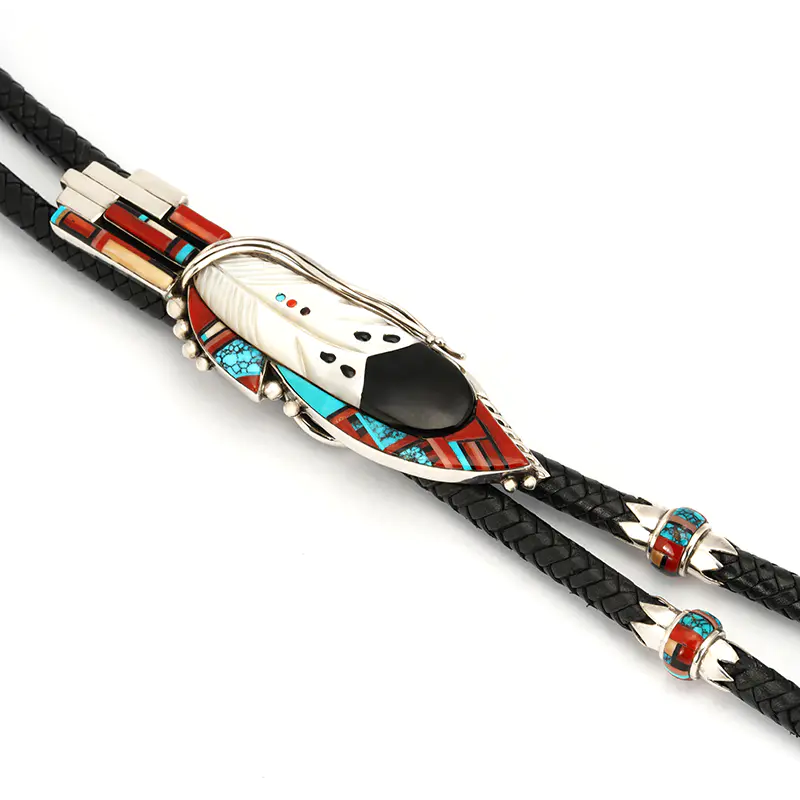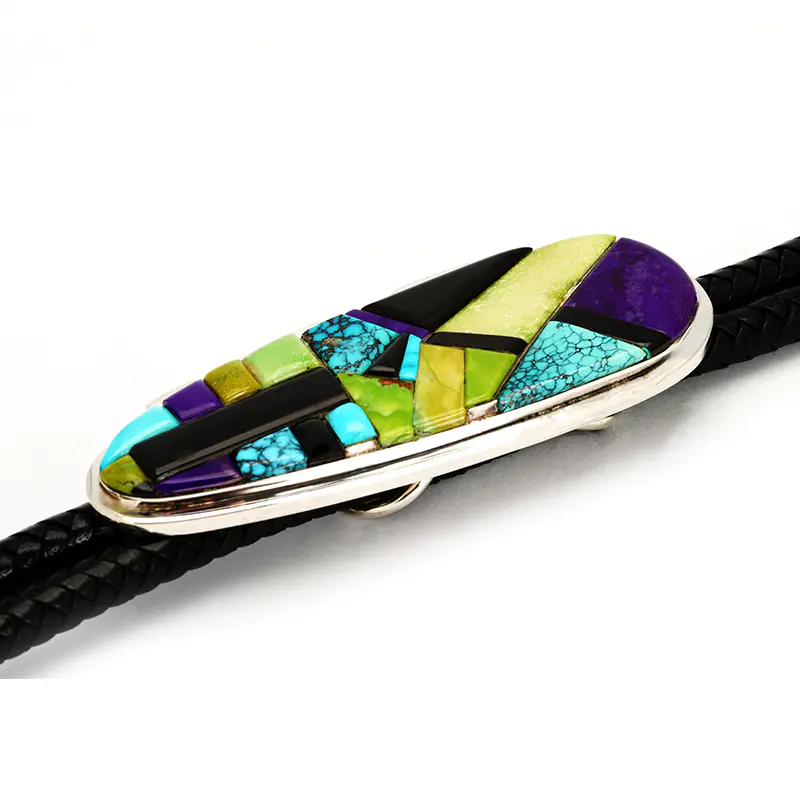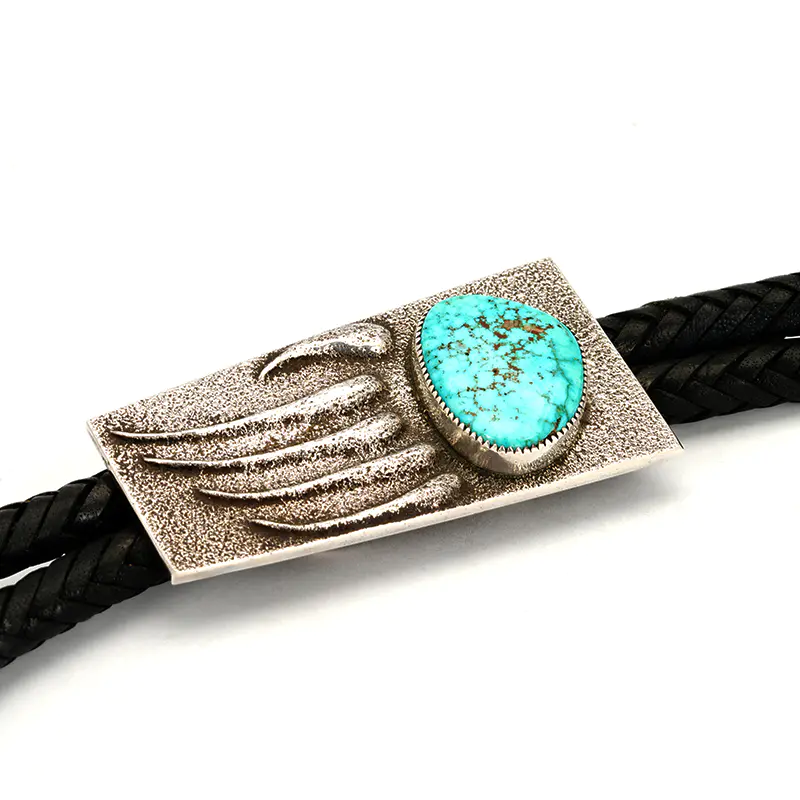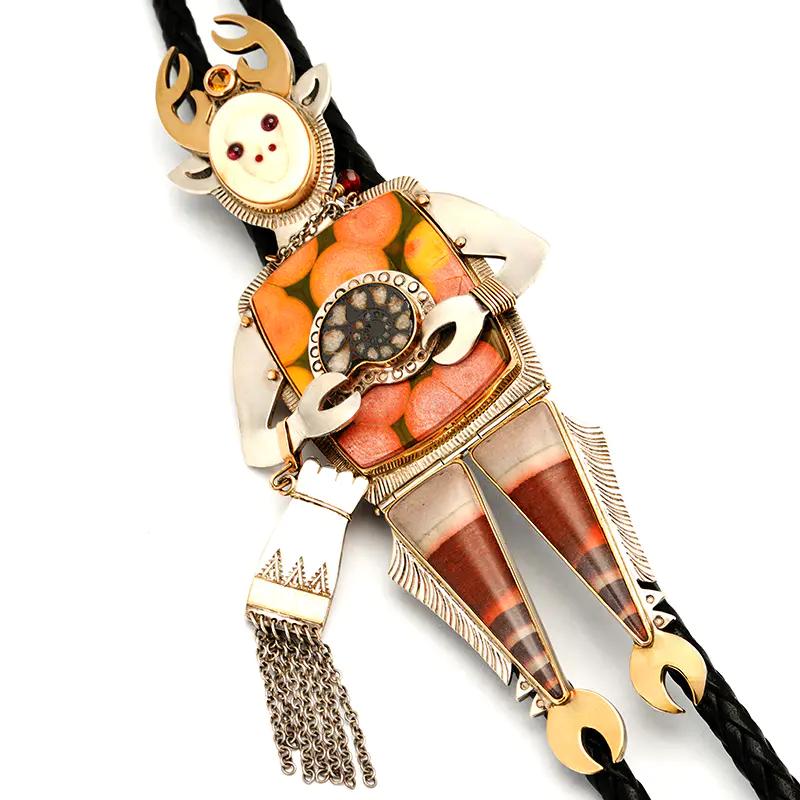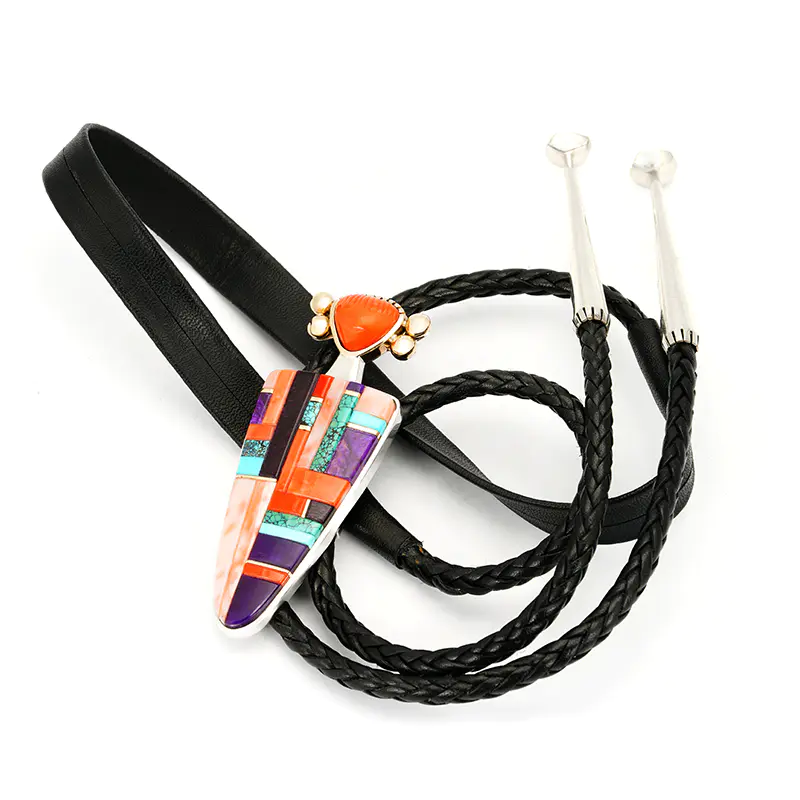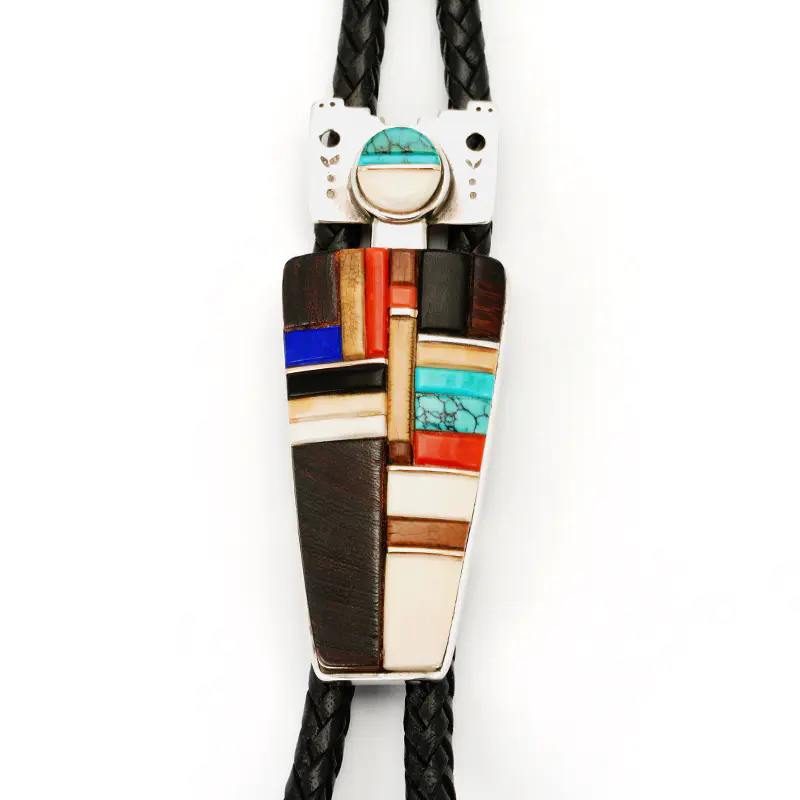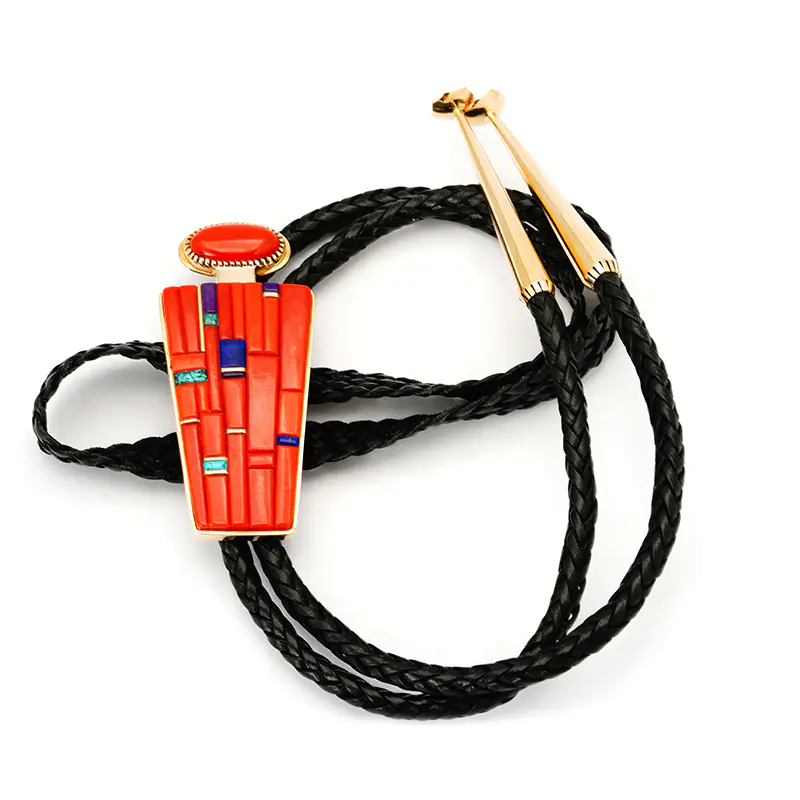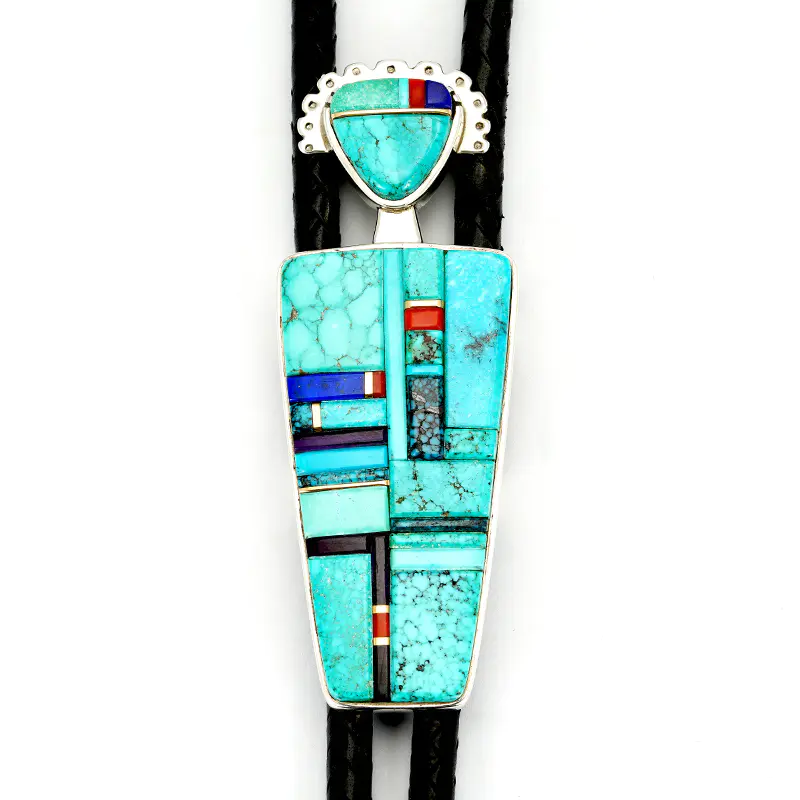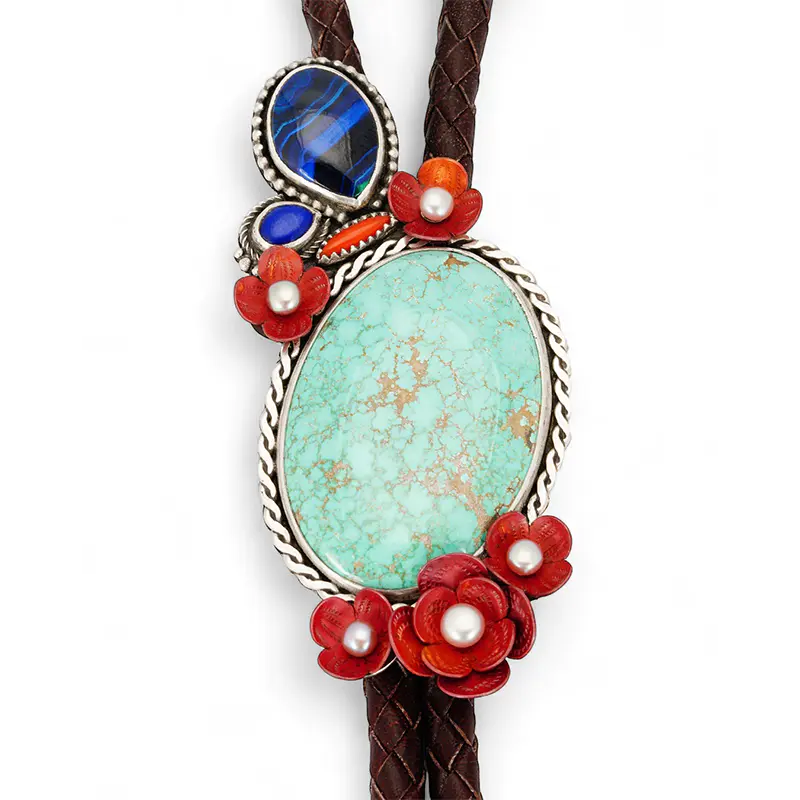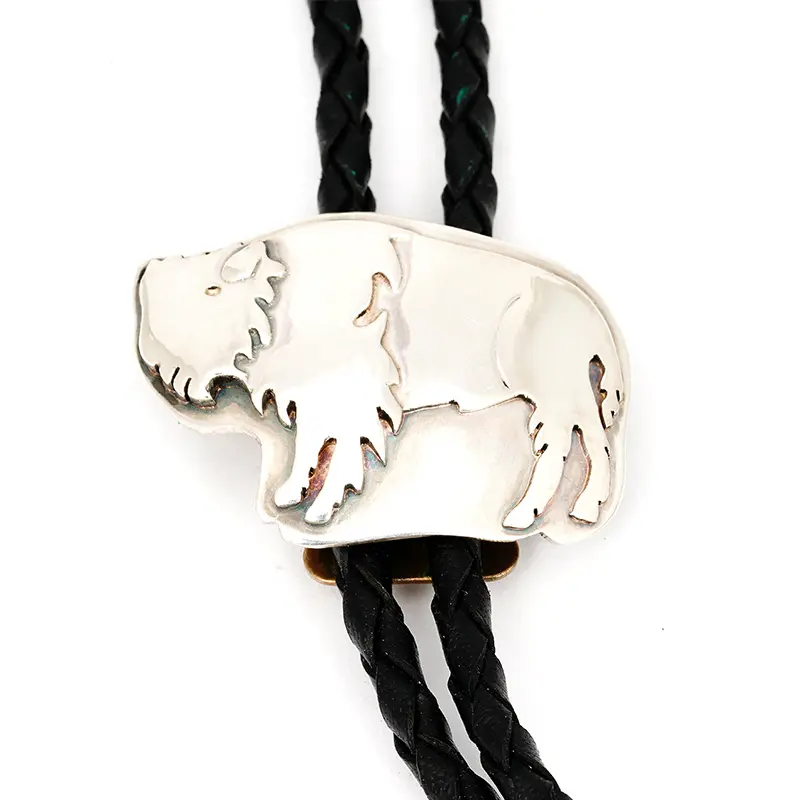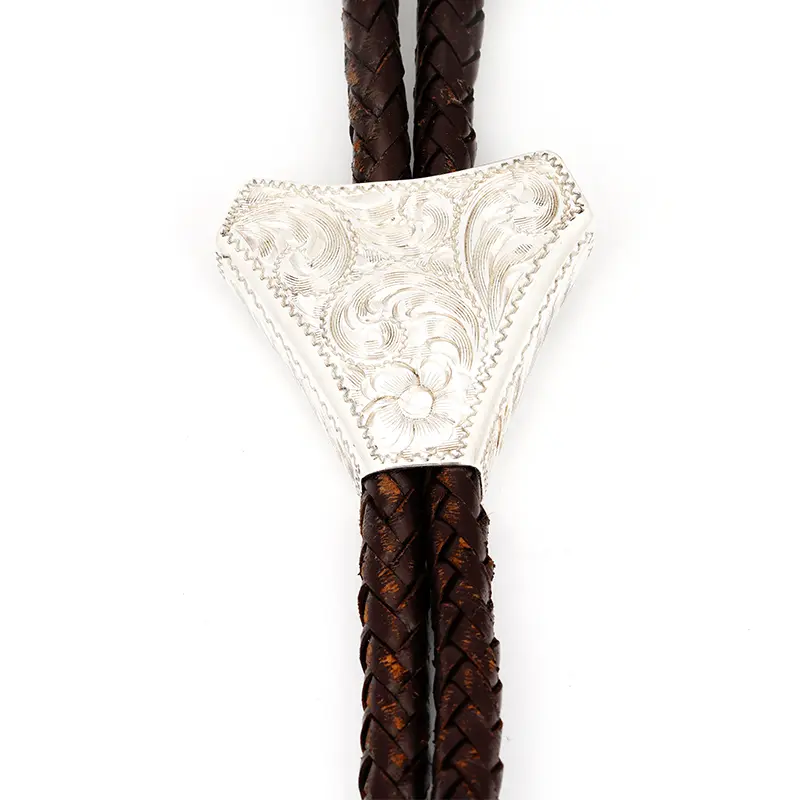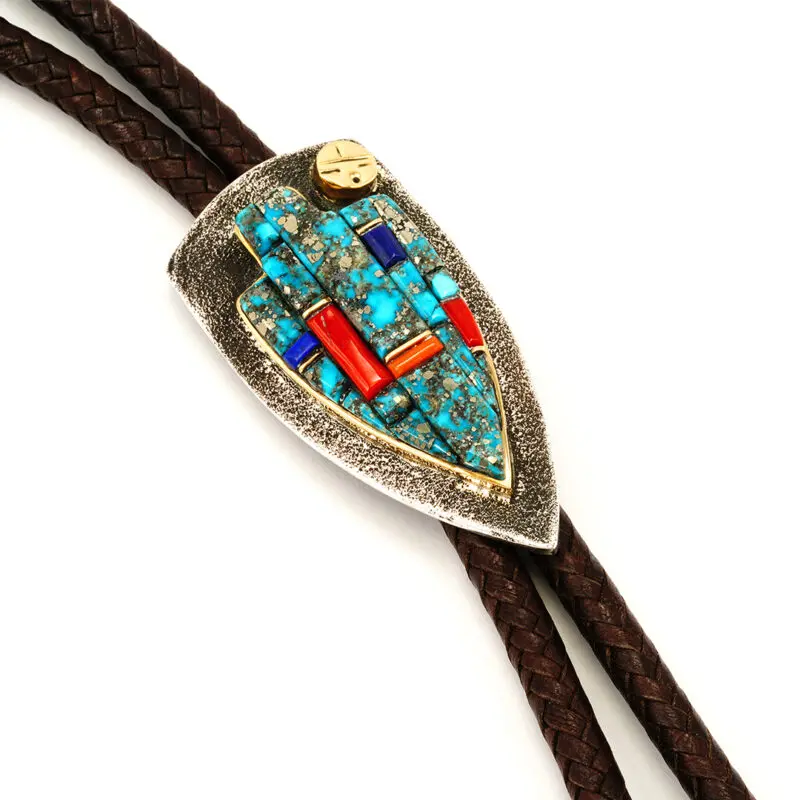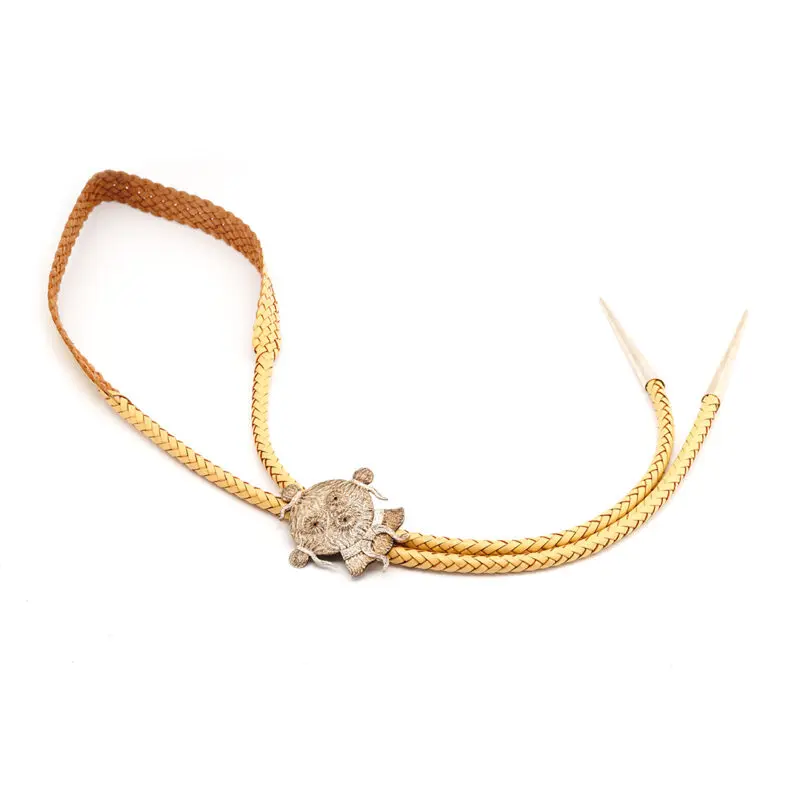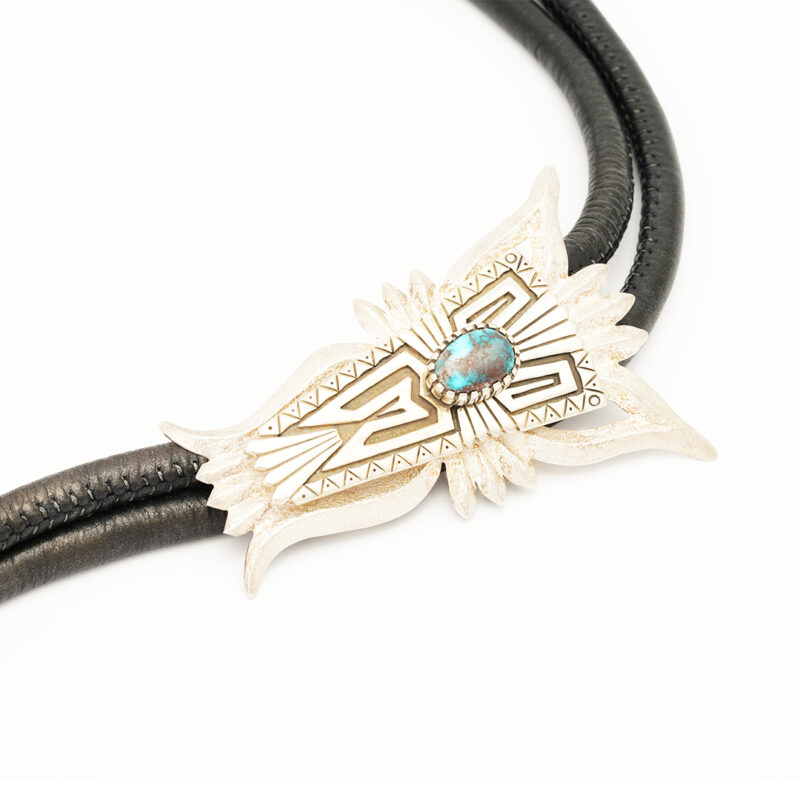Bolo Ties
The History of Bolo Ties: American Indian Innovation, Identity, and Art
Few pieces of jewelry are as emblematic of the American Southwest as the bolo tie. With its distinctive cord and slide design, the bolo has long been associated with Western style—but in the hands of American Indian artists, it has evolved into a powerful medium for cultural expression and fine art. From early silver conchos to today’s micro-inlay masterpieces, the bolo tie’s journey is deeply intertwined with Native creativity and tradition.
Origins of the Bolo Tie
The bolo tie began gaining popularity in the 1940s and 1950s, emerging as a stylish alternative to the necktie—especially among Western and Southwestern communities. Its roots, however, trace back further. Early Navajo and Pueblo peoples used silver scarf slides or concho buttons to fasten cloth, which some believe influenced the bolo’s eventual form.
By the mid-20th century, Native jewelers across the Southwest—particularly among the Navajo, Zuni, and Hopi—were making bolos that fused silverwork, stone setting, and symbolic imagery, turning the bolo into a wearable canvas of tribal identity and craftsmanship.
Native Bolo Ties: A Tradition Reimagined
Historic Native bolo ties reflect the distinctive techniques of each tribal group:
-
Navajo artists often used heavy silver stamping, repoussé, and natural turquoise to create bold, sculptural bolos.
-
Zuni jewelers brought their exceptional stone inlay, petit point, and needlepoint work to the bolo form, crafting intricate mosaics that often depicted sacred animals, celestial symbols, and ceremonial themes.
-
Hopi silversmiths, through their hallmark overlay technique, created bolos featuring stylized katsinas, migration symbols, and other spiritual imagery.
These pieces were—and still are—worn with pride in both ceremonial and everyday contexts, representing not just style, but spiritual meaning and cultural lineage.
Contemporary Masters and the Evolution of the Bolo Tie
In the hands of today’s Native artists, the bolo tie has transformed into a bold expression of contemporary fine art. Artists push boundaries in form, scale, and material—without ever losing sight of their heritage.
Charles Loloma (Hopi): A true pioneer, Loloma introduced gold, exotic stones, and sculptural inlay into bolo designs, turning each piece into a three-dimensional, architectural artwork.
Jesse Monongya (Navajo): Known for his celestial themes, Monongya incorporates su, opal, lapis, and turquoise into intricate inlay bolos that echo Native cosmology and personal narrative.
Raymond Yazzie (Navajo): Famed for his dazzling stone-to-stone inlay, Yazzie crafts bolos with intense precision, color, and symmetry—each one a showpiece of geometry and meaning.
Ric Charlie (Navajo): A master of tufa casting, Charlie creates bolos with rich surface texture, oxidized detail, and cultural motifs. His process—carving designs into soft tufa stone molds—results in deeply sculptural, uniquely tactile pieces.
Carl and Irene Clark (Navajo): Renowned for their extraordinary micro-inlay work, the Clarks craft bolo ties with astonishing detail—often setting over 1,000 tiny hand-cut stones into a single piece. Their designs feature eagle dancers, yei figures, traditional textiles, and cosmological patterns, all rendered in intricate mosaics of turquoise, coral, jet, lapis, and mother of pearl. Their bolos are not only technical marvels, but cultural masterpieces, preserving sacred stories through stunning miniature inlay. The precision of their craftsmanship places them among the most respected artists in contemporary Native jewelry.
The Bolo Tie Today: A Cultural Icon, A Work of Art
While it’s now the official state neckwear of Arizona, New Mexico, and Texas, the bolo tie holds a deeper role in Native communities—as a symbol of continuity, artistic evolution, and individual expression.
Contemporary Native bolo ties range from sleek and minimalist to large-scale sculptural works. Whether worn at a traditional gathering or displayed as a collector’s item, they reflect the living heartbeat of Native jewelry: innovation grounded in culture.
At Faust Gallery, we proudly showcase a curated collection of bolo ties, from early silver classics to modern masterpieces by artists like Charles Loloma, Jesse Monongya, Raymond Yazzie, Ric Charlie, Carl and Irene Clark, and many more.
-
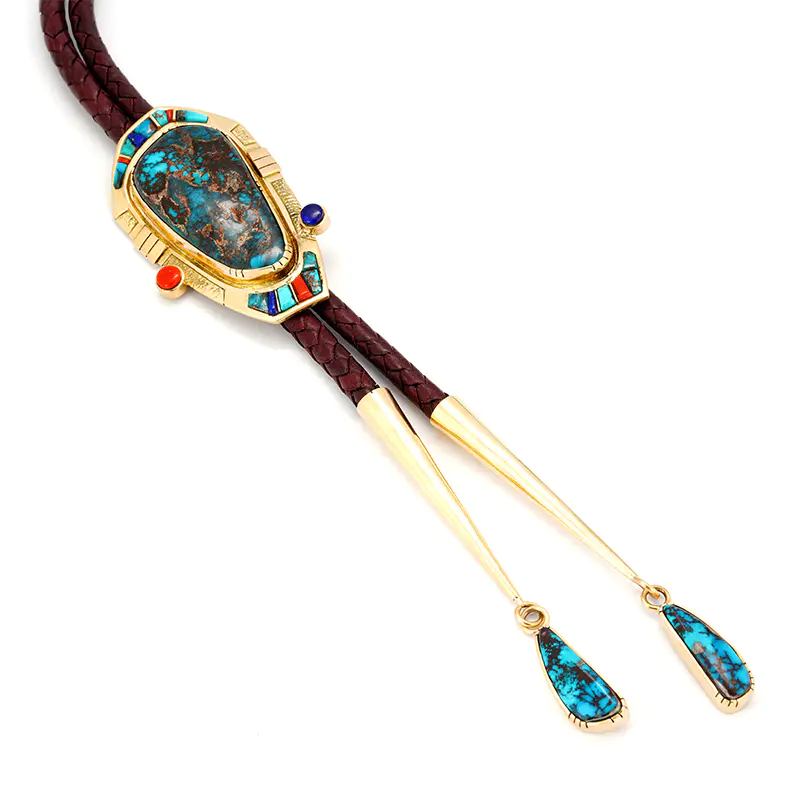
Willie, Wes 18K Gold Inlaid Large Bisbee Stone Bolo Tie
$34,000.00 Add to cart -

Supplee, Don Longhair Kachina Sterling Silver Inlaid Bolo Tie
$5,700.00 Add to cart -

Curtis, Jennifer MMIW Bolo Tie + Rsay Curtis Red Cord With Horsehair Tips
Read more -

Panteah, Myron Sterling Silver Bolo Tie
$9,500.00 Add to cart -

Clarence & Russell Lee Figure Truck Bolo Tie
Read more -

Willie, Wes 18K Gold Inlaid Bolo Tie “War Bonnet”
$32,000.00 Add to cart -

Horse, Michael Silver Stylized Kachina Bolo Tie
Read more -

Poblano, Veronica Silver Feather Bolo
$12,000.00 Add to cart -

Poblano, Veronica Sterling Silver Bolo tie With Inlay
Read more -

Horse, Michael Sterling Silver Bear Claw Turquoise Bolo Tie
Read more -

Adams, Victoria. Silver and Gold Figure Bolotie
$18,000.00 Add to cart -

Sonwai (Verma Nequatewa) Sterling Silver and Gold Inlaid Bolotie
$11,500.00 Add to cart -

Sonwai (Verma Nequatewa) Butterfly Maiden Sterling Silver Bolo With Inlay
$5,500.00 Read more -

Sonwai (Verma Nequatewa) 18K Gold Stylized Coral Inlaid Figure Bolo And Pendant
Read more -

Sonwai (Verma Nequatewa) Sterling Silver Inlaid Stylized Figure bolo and Pendant
Read more -

Wallace, Liz Sterling Silver Floral Bolo Tie
Read more -

Sterling Silver Buffalo Bolo Tie
$600.00 Add to cart -

Cedarstaff, Victor Sterling Silver Hand Engraved Bolo Tie
$600.00 Read more -

Clark, Carl & Irene Micro-Inlaid Sterling Silver Bolo Tie
$12,000.00 Add to cart -

Carl and Irene Clark Micro-Inlaid Silver Bolo Tie “Tree Of Life”
$22,000.00 Add to cart -

Wes Willie Silver Inlaid Bolo Tie With Gold
Read more -

Ric Charlie Tufa Cast Mud Head Bolo Tie
$3,600.00 Add to cart -
Sale!

Tim Herrera Sterling Silver Bisbee Bolo Tie
Original price was: $6,500.00.$4,000.00Current price is: $4,000.00. Add to cart



